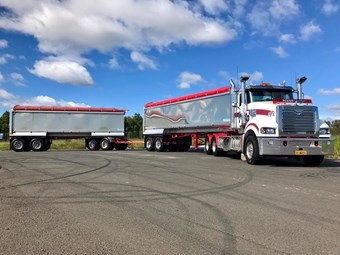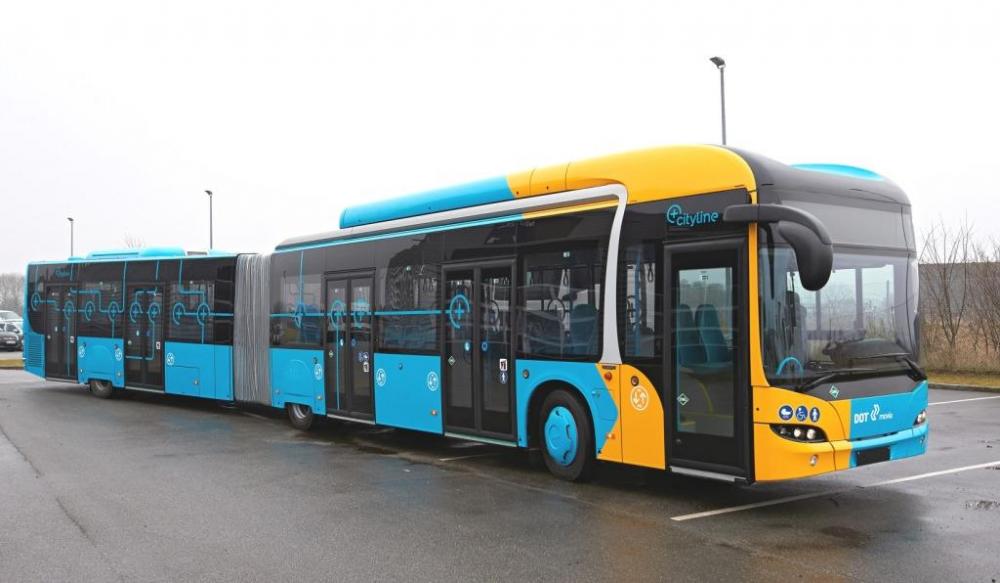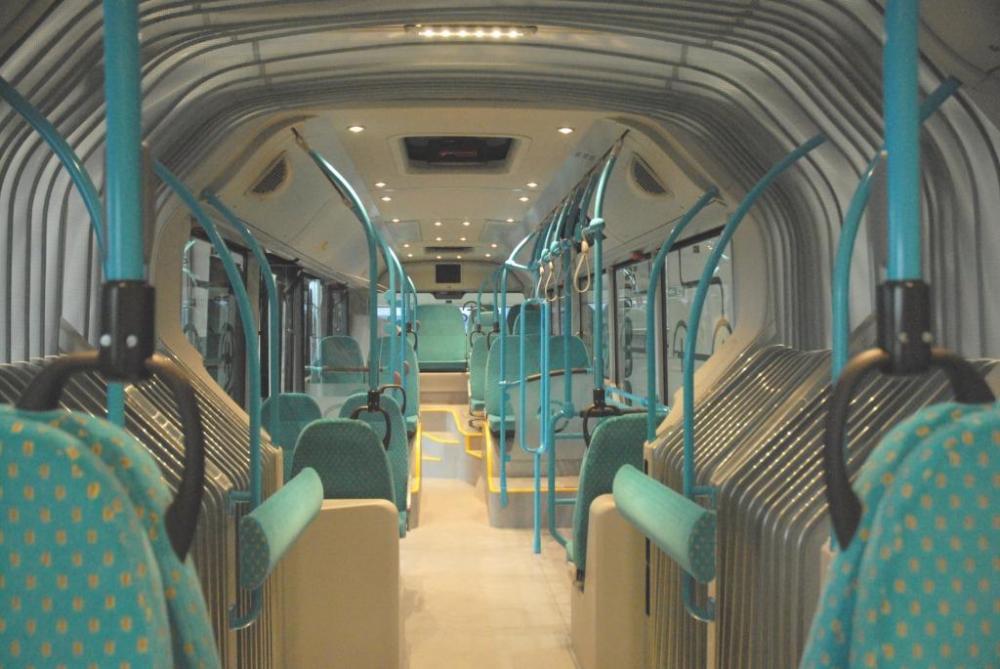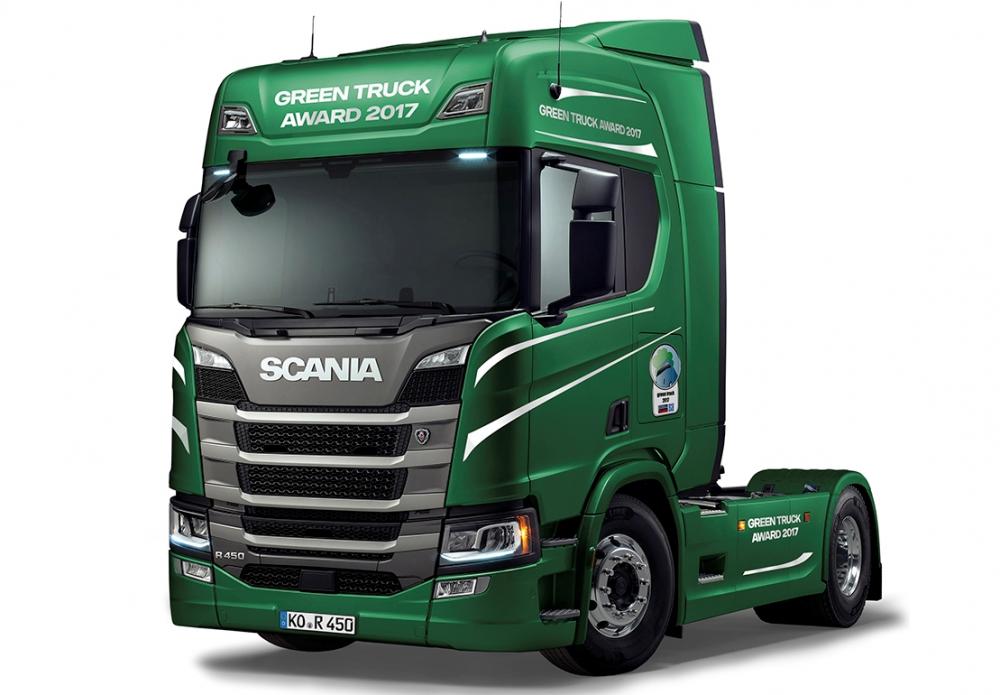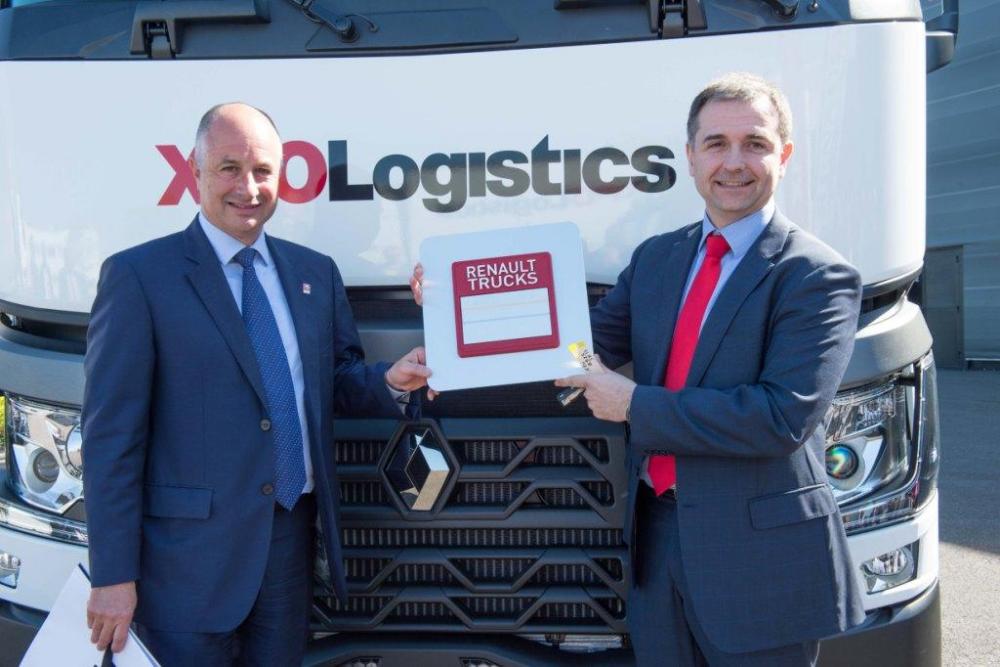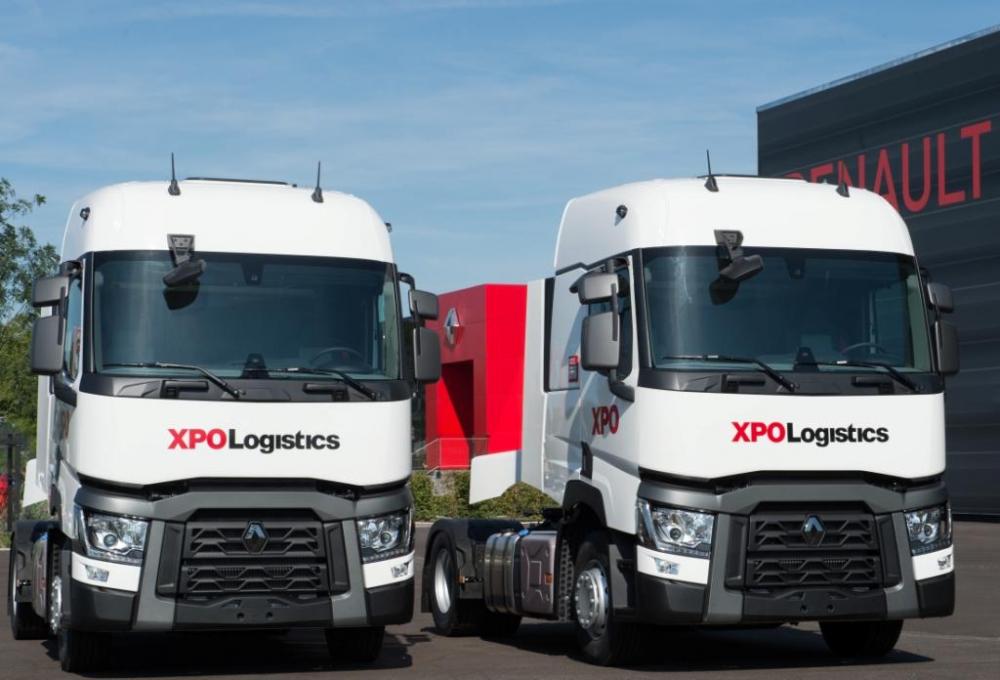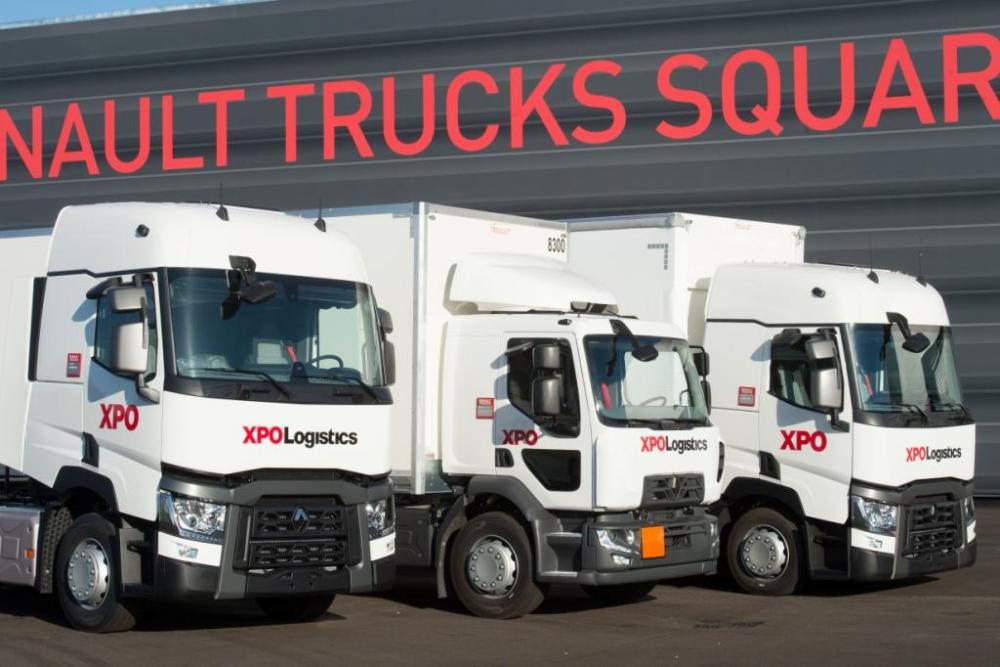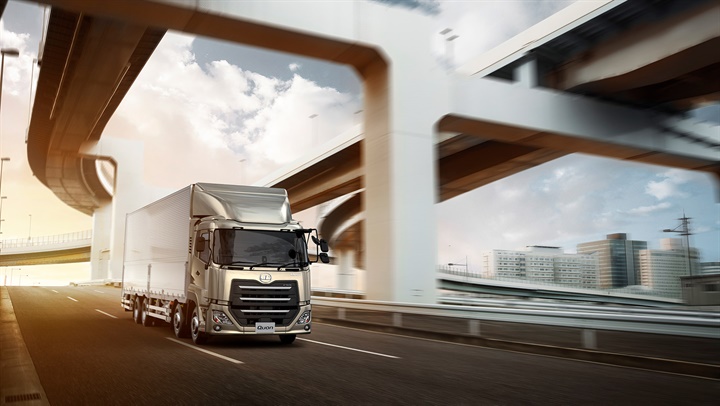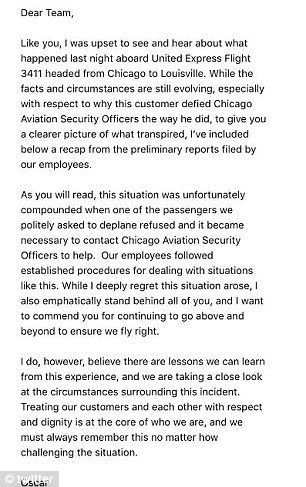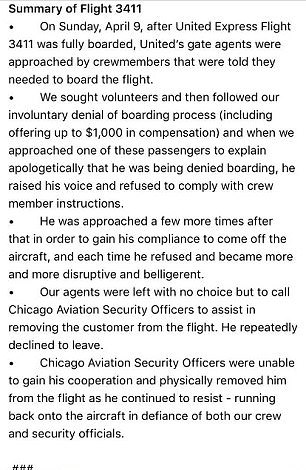
kscarbel2
Moderator-
Posts
18,865 -
Joined
-
Days Won
114
Content Type
Profiles
Forums
Gallery
Events
Blogs
BMT Wiki
Collections
Store
Everything posted by kscarbel2
-
Owner/Driver / April 11, 2017 A KIM Haulage A-double tipper, prepared by Sloanebuilt Trailers, is due to hit the streets in Metro Sydney this week. The performance-based standards (PBS) A-double tipper has an impressive payload of more than 51 tonnes, coming in at 25.6m with a new Mack Superliner up front. This truck further enforces a growing A-double trend around the country, with Sydney looking set to follow in Melbourne’s footsteps. As far as we know, this is the first A-double tipper to operate around metro Sydney, and managing director of KIM Haulage Ken McCelland says it’s only the beginning. "This is the first A-double in my fleet and as far as we know it’s the first A-double tipper in NSW," Ken said. "In my opinion once RMS sees this, they’ll start replacing B-doubles. "It carries more than my B-double yet it’s shorter. "This combination also corners better than my 5-axle setups.’ Business development manager at Sloanebuilt Trailers, Ben Weckwerth, echoed this sentiment citing Sydney’s construction demands. "The A-double market is growing and RMS is doing as much as possible to allow us to use more productive units," Ben said. "It’s a step in the right direction to help with Sydney’s infrastructure boom." While this is KIM Haulage’s first A-double combination, director Ken already has another one planned as he expands his fleet to accommodate local demands. "Our fleet is all PBS, and this is our first A-double," he said. "I went to PBS in 2012 and I’m about to double my operation by putting another 10 PBS-approved truck and trailer combinations on the road this year. "We have all Macks coming, consisting of eight or nine quad-dogs and another A-double." A major sticking point for A-doubles at the moment is their exclusion from the B-double road network, an issue which Ken believes will improve. "RMS wants more productive units and A-doubles mean fewer trucks on the road. "I think they’ll see how safe and productive these A-doubles are and take notice." Sloanebuilt Trailers are getting behind the demand for A-doubles, as the New South Wales market continues to grow. "We’re rolling A-doubles into being a serious part of the business," Ben said. Related reading - https://www.bigmacktrucks.com/topic/48726-maxwell-freightlines-pioneers-high-productivity-interstate-road-trains-from-melbourne/#comment-361539.
-
Frost & Sullivan Press Release / April 11, 2017 Freightliner's deployment of class-leading technology will help it deliver the lowest RCO to customers Based on its latest survey of US Heavy-Duty Fleet Managers, Frost & Sullivan* recognizes Freightliner Trucks with the 2016 US Frost & Sullivan Award for Product Leadership. Managers of heavy-duty truck fleets identified Freightliner as having the most comprehensive and cost-effective mix of advanced technologies. It leads in both the top weighted mean score (WMS) and loyalty index (LI), and has the highest normalized Product Leadership Index (PLI) score of 10.0. It has far outdone the second and third ranked companies, which have PMIs of 5.7 and 4.7. Freightliner's sustained focus on leveraging advanced technologies for a reduced Real Cost of Ownership℠ (RCO) and uptime maximization, as well as assimilating continuous customer feedback, has helped Freightliner achieve market leadership. It has effectively packaged these advancements in the technology clusters of powertrain, chassis, safety, connectivity, and regulation compliance technologies. This delivers value in the form of a low life cycle cost for fleets and owner/operators. "Fleet managers of the largest private and for-hire fleets in US rank Freightliner as the leading original equipment manufacturer (OEM) in the area of advanced truck technologies," said Frost & Sullivan Senior Research Analyst, Silpa Paul. "Freightliner's RCO optimization strategy is focused on deploying advanced powertrain technology to reduce fuel consumption and cost, safety features to reduce accident propensity, and connectivity/solution-enabled fleet management to improve vehicle uptime." As fuel efficiency has become an increasingly important component of RCO, Freightliner's engineers have responded with next-generation diesel engines and powertrains alongside compressed and liquefied natural gas options. The company's proprietary full-scale wind tunnel enables it to design aerodynamic vehicles that deliver the power customers demand while reducing fuel consumption. Although the incorporation of advanced technologies can result in higher upfront investment, fleet managers recognize the long-term savings on operational life cycle costs. "Freightliner's product leadership is further strengthened by accepting feedback from customers regarding product attributes and value design processes," noted Paul. "The company is in constant dialogue with members of its customer council, its dealers and technicians through formal in-person meetings as well as casual communications, in order to be able to incorporate valuable customer feedback in the product design." In addition to an open line of communication with dealers, technicians and customers, Freightliner's parent company, Daimler Trucks North America LLC's (DTNA) market research & analytics team proactively seeks customer feedback from high-value customers on its own as well as its competitor's products. For such proactive initiatives to develop a world-class product, Frost & Sullivan is pleased to present Freightliner with the 2016 US Frost & Sullivan Award for Product Leadership. "Freightliner has been an innovative and customer-centric company since its inception," said Mary Aufdemberg, director of product marketing, Freightliner Trucks. "This Product Leadership Award upholds our reputation as a leader in technology, and providing the best solutions to our customers for their success, and we receive it proudly." Each year, Frost & Sullivan presents this award to the company that has developed a product with innovative features and functionality that is gaining rapid acceptance in the market. The award recognizes the quality of the solution and the customer value enhancements it enables. Frost & Sullivan's Best Practices Awards recognize companies in a variety of regional and global markets for outstanding achievement in areas such as leadership, technological innovation, customer service, and product development. Industry analysts compare market participants and measure performance through in-depth interviews, analysis, and extensive secondary research. * Frost & Sullivan is a leading global market research and analysis firm.
-
Eaton, Cummins to Form Joint Venture for Automated Transmissions
kscarbel2 replied to kscarbel2's topic in Trucking News
Eaton and Cummins Inc. Announce Joint Venture Cummins Press Release / April 10, 2017 Eaton and Cummins today announced an agreement to form a joint venture for automated transmissions for heavy-duty and medium-duty commercial vehicles. The joint venture will be named Eaton Cummins Automated Transmission Technologies. Cummins and Eaton will each own 50 percent of the new joint venture. The formation of the joint venture is subject to regulatory approvals and customary closing conditions. The parties expect the transaction to close in the third quarter of 2017. Cummins will consolidate joint venture results as part of its Components business segment. “Customers are focused on powertrain solutions that provide the best combination of technology, performance and quality,” said Craig Arnold, Eaton chairman and chief executive officer. “Our joint venture with Cummins will leverage the technical strengths and experience of two industry leaders with long histories and deep industry expertise to provide superior automated transmission technology for our global customers.” “Our growth strategy includes expanding our product offerings and extending our global footprint by becoming the world’s leading powertrain supplier,” said Tom Linebarger, chairman and CEO, Cummins Inc. “Our JV with Eaton will deliver the most advanced automated transmissions and develop an integrated powertrain and service network that supports our customers like never before. Just as we’ve done for the past 100 years, we will use our experience in partnerships and technological expertise to ensure our customers’ success.” The global joint venture will provide customers with industry-leading transmission technologies and solutions that deliver best-in-class fuel efficiency, performance and uptime while leveraging both Cummins’ and Eaton’s global service and support networks. The joint venture will design, assemble, sell and support all future medium-duty and heavy-duty automated transmissions for the commercial vehicle market. Eaton’s current medium-duty automated transmission, Procision®, and next generation heavy-duty automated transmissions, will be part of the joint venture. In addition, the joint venture will market, sell, and support Eaton’s current generation of automated heavy-duty transmissions to OEM customers in North America. Eaton’s Vehicle Group will retain its global manual transmission business, global clutch business, current generation medium-duty and heavy-duty automated transmission business outside of North America, global aftermarket business, light-duty transmission business, agricultural transmission business, and global automotive business and associated product lines. Under the terms of the agreement, Eaton will receive $600 million in cash from Cummins for 50 percent interest in the joint venture. Conference Call with Eaton Management at 1:00 p.m. Eastern, April 10, 2017 Eaton’s conference call to discuss the joint venture is available to all interested parties as a live audio webcast today at 1 p.m. United States Eastern time via a link on the center of Eaton’s home page. This news release can be accessed under its headline on the home page. An audio replay of the webcast will be available at the same link. Cummins leadership will comment further on the joint venture and answer investor questions during its Q1 2017 Earnings call on May 2 at 10 a.m. ET. -
The Guardian / April 11, 2017 White House press secretary Sean Spicer said he was “sure” that Donald Trump had seen the video. “I don’t think anyone looks at that video and isn’t a little disturbed that another human being is treated that way,” he told reporters. “Clearly watching another human being dragged down an aisle, watching blood come from their face after hitting an armrest or whatever, I don’t think there’s a circumstance that you can’t sit back and say this probably could have been handled a little bit better, when you’re talking about another human being.” ----------------------------------------------------------------------------------------------------------------- CNN / April 12, 2017 The man who ended up bloodied and screaming Sunday night, Dr. David Dao, had initially agreed to get off the plane, passenger Jayse Anspach said. "Him and his wife, they volunteered initially," Anspach said. "But once they found out that the next flight wasn't until (Monday) at 2:30 p.m., he said, 'I can't do that. I gotta be at work.' So he sat back down." The harder the officers tried to get the man to leave, the harder the man insisted he stay. "He was very emphatic: 'I can't be late. I'm a doctor. I've got to be there tomorrow,' " Anspach recalled.
-
White House Press Secretary Sean Spicer is under fire for saying Hitler didn't use chemical weapons Los Angeles Times / April 11, 2017 Spicer, overlooking the gas chambers, said Hitler ‘didn’t even sink to using chemical weapons’ White House Press Secretary Sean Spicer appeared to forget about the Holocaust when comparing Hitler with Syrian President Bashar Assad during a cringe-worthy televised briefing with reporters on Tuesday. “You had someone as despicable as Hitler who didn’t even sink to using chemical weapons," Spicer said, in an attempt to argue that Russia and other countries that are not standing up to Assad are on the wrong side of history. Spicer's rendering ignored the horror of the Holocaust, where gas chambers were used as part of a genocide campaign that killed 6 million Jews as well as millions of others including Gypsies and gay people. “You had someone as despicable as Hitler who didn’t even sink to using chemical weapons.” Sean Spicer Many expressed shock as Spicer went on to field other questions. Spicer was given a chance to recover in a follow-up question, but instead evoked more gasps. “He was not using gas on his own people the same way,” Spicer said. He referred to the Syria bomb victims as "innocent." He then added awkwardly that he was aware of "Holocaust centers" and that he meant that Hitler did not use gas in the middle of towns. The suggestion that Holocaust victims were not Hitler's "own people" — intended or not — hit a sore nerve for Jews and other victims who considered themselves loyal subjects of Germany. There is also a painful and long history of Holocaust deniers who claim, among other things, that gas chambers were not used to kill Jews. Spicer's comments came during Passover, in which Jews celebrate freedom from oppression. After the press briefing ended, Spicer released another clarification in written form: "In no way was I trying to lessen the horrendous nature of the Holocaust," he said. "I was trying to draw a distinction of the tactic of using airplanes to drop chemical weapons on population centers [exactly as Japan’s Unit 731 did in WW2]. Any attack on innocent people is reprehensible and inexcusable." . .
-
Trump and Immigration (Illegal Immigrants in the US)
kscarbel2 replied to kscarbel2's topic in Odds and Ends
Detained [illegal] immigrants launch hunger strike in Washington state Reuters / April 11, 2017 Hundreds of [illegal alien] detainees at an immigration holding center in Washington state began refusing meals in a hunger strike to protest conditions at the facility and delayed immigration hearings [humorous given they are uninvited guests]. A group of about 100 detainees at the Northwest Detention Center in Tacoma, Washington, refused their lunches on Monday, with 300 others joining the protest that night and the following morning. The 1,575-bed facility houses immigrants awaiting hearings or deportation after being arrested by U.S. Immigration and Customs Enforcement (ICE) agents. The Tacoma protesters' demands include expedited legal proceedings and higher-quality food. Seattle ICE spokeswoman Rose Richeson said the agency was aware of the situation in Tacoma but said it would not count as a hunger strike under ICE guidelines until it had lasted at least 72 hours. Any detainees that do cross the 72-hour limit can be isolated and could eventually be ordered by a court into medical care [at U.S. taxpayer expense], according to ICE guidelines. Richeson declined to comment on demands by the protesting detainees. -
MAN Truck & Bus Press Release / April 11, 2017 With room for up to 150 passengers and five automatic sliding doors, 41 MAN Lion’s City GL CNGs will help to speed up local public transport in Copenhagen. These special city buses will be used for the new BRT line in the north of the Danish capital. Movia is deploying 41 articulated buses with MAN’s CNG drives on the new BRT line in the north of Copenhagen The operator Arriva was convinced by MAN’s well thought-out concept and striking design A bus – a feast for the eyes: the modern design of the 41 MAN Lion’s City GL A40 CNGs is a real eye-catcher. And this is a significant aspect for operators, Arriva, and for Movia, the largest transport company in Denmark, because these articulated buses will run on the new BRT line, from Herlev, in the north of Copenhagen, through the city centre to the airport. “The City Line is Movia’s first BRT line. On a number of sections these buses have their own bus lane, and that is why the vehicle needs to stand out”, says Klaus Kormann, International Key Account Manager at MAN Truck & Bus, adding “thanks to features such as the fairing, with its large individual headlights, the futuristic wheel arch covers and translucent bellows, it really does.” Since Movia does not itself own any vehicles, Arriva will be operating the line on its behalf. MAN won over Arriva and Movia not only with MAN Lion’s City GL A40 CNG’s design, but especially with the ingenious vehicle concept. It combines high passenger capacity with extremely rapid passenger flow. The 18.75 metre long city buses have five 1,250 mm wide, double-leaf swivel sliding doors and an optimized electric drive. “This considerably reduces stopping time, which saves not only time but also fuel”, explains Kormann. In addition, they can each carry more than 150 passengers on comfortable seats and generous standee platforms. To see just why the demand for city buses is so high, let’s take a look at the “City Line”: with more than 20 million passengers a year and up to 75,000 passengers a day, it is the busiest line in the north of Denmark’s capital. Video cameras monitor the buses’ interior to ensure drivers can keep an eye on everything, however many passengers they have. There are also numerous safety features, such as EBS, plus ABS and anti-slip regulators, and light barriers on the swinging-sliding doors. The 310 HP (228 kW) city buses are fuelled with biogas. This means that MAN’s Lion’s City GL A40 CNGs have extremely low-emissions, making them a climate-friendly and economical mobility solution for urban transport. “Fueled with bio-gas, these articulated buses are practically CO2-neutral, making them equivalent to full-electric vehicles”, says Kormann. Around 1,250 buses, which is one third of Denmark’s entire local public transport fleet, operate under Movia’s flag. The transport company commissioned Arriva, Keolis, Nobina and local Danish operators as subcontractors. Arriva Danmark A/S, a 100% subsidiary of Deutsche Bahn, currently operates almost 40% of Movia’s buses. .
-
Volvo Trucks - System for services and infotainment
kscarbel2 replied to kscarbel2's topic in Trucking News
-
Scania Group Press Release / April 11, 2017 Scania’s new generation R 450 Highline truck has been given the prestigious Green Truck 2017 award in Germany by the leading trade magazines VerkehrsRundschau and Trucker. The award is based on Scania R 450’s superior fuel performance in VerkehrsRundschau’s and Trucker’s comparative on-road testing. The figures speak for themselves – an average consumption of 23.7 litres/100 km. “Sustainability, whether through alternative fuels or fuel-efficient diesel vehicles, is a key issue for Scania and its customers,” says Peter Hornig, Managing Director of Scania Deutschland Österreich. “By reducing fuel consumption, we reduce CO2 emissions and at the same time costs. Thus, sustainability and profitability go hand in hand.” Sustainable transport is profitable In VerkehrsRundschau’s and Trucker’s test, Scania was set against three competing brand tractor units with a maximum weight of up to 40 tonnes. “Ultimately, the Swedish manufacturer was able to prove its value for drivers,” the magazines wrote. “Also in terms of profitability, the Scania R 450 was not to be surpassed. No wonder the crown went to Sweden this year.” Scania introduced its new generation trucks in autumn 2016 and they have since overtaken the competition in several comparative European media tests. .
-
Renault Trucks Press Release / April 11, 2017 On Monday, 10 April 2017, in Renault Trucks Square in Lyon, Renault Trucks and XPO Logistics celebrated the signing of a two-year contract for the investment of tens of millions of euros by XPO Logistics in Renault Trucks “Guaranteed French Origin” vehicles. . During the ceremony, Bruno Blin, President of Renault Trucks, handed over the keys to the 2,500th Renault Trucks Euro 6 vehicle of the XPO Logistics Europe fleet to Luis Angel Gomez, XPO Logistics’ Managing Director, Transport Solutions–Europe. The new two-year contract demonstrates the strong relationship between the two companies, which dates back to 1979, and their continued commitment to French manufacturing expertise. Designed and manufactured in France since 1894, Renault Truck vehicles carry the “Guaranteed French Origin” label, a certification that promotes the expertise of its production sites located in Blainville-sur-Orne (Calvados), Bourg-en-Bresse (Ain) and Lyon (Rhône). Renault Trucks vehicles are the only trucks to carry this official certification, awarded by the association ProFrance. The label was recently renewed until 2020. XPO Logistics, one of the ten largest global providers of transport and logistics services, has long been committed to investing in trucks made in France, regularly renewing its fleet in order to provide its drivers and customers with high-performance, efficient and reliable work tools that meet the highest environmental standards. As Luis Angel Gomez, Managing Director, Transport Solutions–Europe at XPO Logistics, explained, “The renewing of our longstanding collaboration with Renault Trucks is further proof of our desire to continue investing in a “Guaranteed French Origin” fleet over the forthcoming years.” Bruno Blin, President of Renault Trucks, emphasised, “Delivery of this 2,500th Renault Trucks Euro 6 truck and the signing of this two-year contract demonstrate the confidence XPO Logistics has in our brand and the quality of French products. Our desire is to support XPO in its growth, supplying it with high-performance transport solutions that meet the demands of its customers and operations.” The 2,500 Renault Trucks Euro 6 trucks in service in XPO Logistics’ fleet are from the distribution and long-distance D and T ranges, and are used for regional, national and international transport. .
-
MAN Truck & Bus Press Release / April 11, 2017 Less friction, more efficiency. MAN Genuine Oil. MAN Genuine Oils are proven to provide ideal protection against wear and thus help to increase the vehicle’s service life and lower its total cost of operation. MAN Genuine Oil: small difference, big impact. .
-
Eaton, Cummins to Form Joint Venture for Automated Transmissions
kscarbel2 replied to kscarbel2's topic in Trucking News
Actually, in the old days, we were a very small vendor customer. Cummins and Eaton were our competition. Sure, we built some Cruise-liners with Cummins-Eaton drivetrains because Ryder demanded it. But we promoted the superior Mack "balanced design" drivetrain, resulting in "pedigreed" trucks representing over 90 percent of production. I recall when Air Products ordered R-models with Silver 6V92s, They...........regretted it. -
Heavy Duty Trucking / April 11, 2017 The Truckload Carriers Association (TCA) reiterated its support of the current five-axle, 80,000-pound federal gross vehicle weight limit for trucks in an April 5 letter to the leaders of both the Senate Committee on Appropriations and the House Committee on Appropriations. TCA President John Lyboldt wrote the lawmakers that the association and its trucking company members are “concerned about allowing freight-shipping trucks to carry a maximum of 91,000 pounds with the addition of a 6th axle, up from the current 80,000 pounds standard.” While conceding that this idea is an attempt to improve trucking productivity, he contended that “it clearly would only benefit a minority of carriers, while forcing the rest of the industry either to divert critical resources into these new configurations or risk becoming obsolete.” Interestingly, that is often the strongest argument put up by truckload carriers that oppose liberalizing federal rules to allow 33-foot-long “turnpike” double trailers to operate on Interstate and other highways— regardless of state laws. T TCA was among the groups that lobbied Congress successfully to keep a measure allowing twin 33s from being passed in 2015. As to whether carriers should be allowed to run heavier when rigs are equipped with a 6th axle, about a year ago TCA did opt to ditch a two-policy position it had held since 2011 that called for increasing truck weight limits either by allowing a five-axle, 88,000-pound weight limit or six-axle, 91,000-pound limit. In the letter, Lyboldt detailed TCA’s concern that changing the weight limit via a 6th axles would drive up both capital and operating costs for truckload carriers while not allowing them to recoup those costs through rate adjustments. “Truckload’s shift from 48’ trailers to 53’ trailers was exactly this issue, only in reverse,” he pointed out, offering a history lesson. “Shippers who filled trailers by volume before maximizing the allowable weight put pressure on industry to move to 53’ trailers. Like the proposal today, there were pilot programs prior to it being legalized across the nation. Only half of the loads cubed out before they weighed out, yet the entire industry was forced to move.” Lyboldt said that while “the market demands ultimate flexibility from general freight haulers, those who cannot provide the service simply disappear. As has happened before, maximum capacities become the norm. Carriers are forced to adjust their equipment to accommodate 91,000/6, despite the fact that they will likely never recoup the costs of the adjustment or haul loads requiring the 6th axle.” He added that truckload carriers “simply cannot afford” a rule that would allow 91,000 pounds on 6 axles. “TCA supports a policy of no increase in truck weight,” Lyboldt stated flatly in the letter. “As an association, we will continue to examine components of increasing productivity as they arise.” Making his message crystal-clear, he added that “TCA reiterates that we are opposed to the stand-alone concept of 91,000 pounds on 6 axles; however, TCA is open to any and all discussions with key stakeholders in regards to improving overall transportation efficiency and productivity on our nation’s highways.”
-
UD Trucks Rolls Out Flagship Cabover for Japan
kscarbel2 replied to kscarbel2's topic in Trucking News
UD Trucks launches the all-new heavy-duty Quon truck- promising “innovation that puts people first” with advanced solutions across five essential feature areas Ageo, Japan – April 11, 2017 – UD Trucks today launched the all-new Quon, representing a full model change for UD Trucks’ heavy-duty flagship. UD Trucks has a proud heritage that has brought many innovative products and features over the years. But at UD Trucks, innovation goes beyond new technologies. For us, innovation is a commitment to deliver the trucks and services the world needs today, adding value to our customers’ and partners’ businesses and society at large. To serve our customers and partners in an even better way, UD Trucks has over the past few years invested more than during any other period in our history in facilities, in services, in our people, and not at least in our products. The all-new Quon with associated services now moves us into a stronger position in the truck industry. Combining industry-leading fuel efficiency with dynamism and drivability, the all-new Quon offers an unparalleled driveline that delivers a smooth, stress-free and comfortable ride. Quon is equipped with advanced safety features protects the driver and cargo, but also cares for the safety of the vehicle’s surroundings. The comfortable interior lets the driver focus on driving, while the striking and dignified exterior will be a source of pride and joy for anyone in the cockpit. The all-new Quon meets the needs of transport solutions in the modern age by “putting people first” in every fine detail and pushing boundaries further than ever before through leading edge innovations. “The all-new Quon of course complies with the new and stricter emission regulations in Japan. In addition though, it also delivers better performance across the board. Equipped with the ESCOT-VI, the electronically controlled automatic transmission that is the industry benchmark, our heavy-duty flagship truly feels like a passenger car to drive. It offers a complete solution that meets customers’ needs and is sure to earn their satisfaction. Simply put, Quon now better than ever and it embodies UD Trucks promise of Going the Extra Mile for our customers” said Yoshihiro Murakami, President of UD Trucks, at the launch. Discover UD Trucks' all new Quon at https://youtu.be/Ah2KPfKh5Dg The all-new Quon has multiple unique features that combined takes trucking in Japan to an unprecedented performance level. Drivability - easier and smoother to support the driver The cockpit has been redesigned around the way it feels to use it, with operability and visibility ergonomically reengineered from the ground up. The new ESCOT-VI electronically controlled automatic transmission adopts a simple, easy-to-use straight shift pattern, further advancing the Quon’s unrivaled operability while also enhancing its ability to navigate snowy and muddy conditions. All models feature disc brakes as standard, yet another first for Japan. The disc brakes provide a swift, smooth response and outstanding braking performance. Through these features, the all-new Quon provides a comfortable driving environment allowing drivers concentrate on the road ahead. Fuel efficiency - cleaner yet more powerful for improved performance and environmental care The fuel-efficient, powerful and clean 11-liter GH11 engine complies with Japanese 2016 exhaust gas regulations, and all models achieves +5% over the 2015 fuel economy standards for heavy vehicles in Japan. The engine generates powerful torque from low revs up through a wide RPM range, making the Quon a pleasure to drive. To further support fuel-efficient driving, the Quon also features the ESCOT-VI’s Foretrack anticipatory solutions that use GPS to look ahead, as well as the Fuel Coach, a system that displays driving advice to help drivers achieve further improvement in fuel economy. Safety - safer and more reliable for the driver, cargo and surroundings The all-new Quon amongst others features the UD Trucks Traffic Eye Brake system (collision mitigation braking), which uses high-precision radar and a cabin-mounted camera for dual-monitoring of the road ahead, as well as advanced driver assistance systems including Driver Alert Support. Our new flagship is also fitted with disc brakes featuring excellent heat-release properties for superb and industry benchmark anti-fade performance. In combination, these advanced systems deliver enhancements on both active and passive safety. Productivity - more payload and greater efficiency for increased profitability Every component has been refined to realize an overall lighter vehicle, while achieving gains in load-carrying capacity of up to 200kg depending on the model. Improved ease of loading, bodybuilding efficiency and smoothness at creeping speed for approaching loading docks also reflect our uncompromising commitment to boost productivity for our customers. We have also expanded the dry wing-body variations available in the Perfect Quon range and added a refrigeration wing-body. The all-new Quon offers a highly productive range of vehicles optimized for our customers business needs. Uptime - stay on the road to minimize non-revenue generating time The all-new Quon represents a further upgrade in vehicle reliability and durability. It is easier to maintain, with a reduced number of parts requiring regular replacement and longer service intervals on genuine parts. Moreover, comprehensive UD Extra Mile Support including UD Genuine Parts and Service, the UD Trust service agreement, and UD Information Service utilizing the latest in connectivity - keeps customers’ vehicles in the best possible condition to maximize uptime. -
UD Trucks Rolls Out Flagship Cabover for Japan
kscarbel2 replied to kscarbel2's topic in Trucking News
UD Trucks Press Release / April 11, 2017 . . . . . . . -
International Truck Launches “HX” Vocational Series
kscarbel2 replied to kscarbel2's topic in Trucking News
ForConstructionPros / April 11, 2017 -
Heavy Duty Trucking / April 11, 2017 UD Trucks has launched the all-new Quon in the Japanese market as “a full model change” for its heavy-duty flagship. Japan-based UD Trucks is a Volvo Group brand. The OEM said the new model features “industry-leading fuel efficiency with dynamism and drivability,” including a driveline designed to deliver “a smooth, stress-free and comfortable ride.” The Quon is equipped with advanced safety features as well. “The all-new Quon, of course, complies with the new and stricter emission regulations in Japan,” said Yoshihiro Murakami, president of UD Trucks. “It also delivers better performance across the board. "Equipped with the ESCOT-VI, the electronically controlled automatic transmission that is the industry benchmark, our heavy-duty flagship truly feels like a passenger car to drive," he added. "It offers a complete solution that meets customers’ needs and is sure to earn their satisfaction.” UD Trucks said the Quon boasts unique features that take “trucking in Japan to an unprecedented performance level,” including: A cockpit redesigned around the way it feels to use it, with operability and visibility ergonomically reengineered from the ground up. The new ESCOT-VI electronically controlled automatic transmission adopts a simple, easy-to-use straight shift pattern. The fuel-efficient and powerful 11-liter GH11 engine complies with Japanese 2016 exhaust gas regulations, and all models achieve +5% over the 2015 fuel economy standards for heavy vehicles in Japan. The UD Trucks Traffic Eye Brake collision-mitigation system uses high-precision radar and a cabin-mounted camera for dual-monitoring of the road ahead. Advanced driver-assistance systems, including Driver Alert Support Disc brakes feature excellent heat-release properties for superb anti-fade performance. Every component has been refined to realize an overall lighter vehicle, while achieving gains in load-carrying capacity of up to 200 kg depending on the model. Uptime is enhanced because the new truck is easier to maintain, with a reduced number of parts requiring regular replacement and longer service intervals on genuine parts. Sweden's Volvo Group, parent of UD Trucks, has production facilities in 18 countries and sells product in more than 190 markets around the world. .
-
The so-called police/airport security shown in the video are actually nothing less than thugs. Who would ever have thought that we'd see thugs dragging 69-year old customers off of a passenger aircraft right here in America for no other reason than to accommodate a transiting flight crew ?
-
Eaton, Cummins to Form Joint Venture for Automated Transmissions
kscarbel2 replied to kscarbel2's topic in Trucking News
Building a global automated transmission strategy Sean Kilcarr, Fleet Owner / April 11, 2017 New 50/50 joint venture between Cummins and Eaton aims to eventually build global presence in automated transmission market. The formation of Eaton Cummins Automated Transmission Technologies announced by Eaton Corp. and truck engine partner Cummins Inc. this – a new 50/50 joint venture to build automated mechanical transmissions (AMTs) for heavy- and medium-duty commercial vehicles – is part of an effort by the two companies to begin building market share with a style of powertrain that’s in high demand. Last year, for example, Volvo Trucks North America noted that the I-Shift AMT – originally for the European market in 2001 – got spec’d on 83% of its truck models sold in North America back in 2015, with higher percentages expected going forward. Add to that a report issued by the North American Council for Freight Efficiency (NACFE) several years ago that highlighted the fuel-savings potential of AMTs, along with the driver-friendly aspects of automated gearboxes, and the stage is more than set for a big changeover in powertrain selection within the global commercial vehicle market. Ken Davis, president of Eaton’s vehicle group, said that the initial focus of the Eaton/Cummins AMT joint venture will be on commercial vehicles in linehaul highway operating environments, especially where the company’s new heavy-duty AMT scheduled to be unveiled later this year is concerned. “Our next generation product is especially going to start in linehaul highway operation first, then we’ll build up to 18-speed options for other [heavy truck] segments,” he said in a conference call with reporters this week. By contrast, the focus for Eaton’s medium-duty dual-clutch AMT within the joint venture – the Procision – will be on segments such as pickup and delivery trucks and shuttle bus service, with perhaps expansion into the recreational vehicle market, Davis added. Ed Pence, vice president and general manager of the high horsepower engine business at Cummins, added on the call that the discussions about forming this joint venture started back in September 2015 as part of a strategic focal point expressed by Tom Linebarger, chairman and CEO of Cummins. Pence said Linebarger identified powertrains as a “growth market” that Cummins needed to put more focus upon – and the engine maker by that point already had a partnership established with Eaton, Pence noted, which made for a good fit. “We’ve been talking about this since the introduction of Smart Advantage back in 2013,” he explained. “This [joint venture] is the next level opportunity.” Eaton’s Davis added that, as a transmission-focused business, the joint venture will also seek to provide solution for “vertically-integrated” OEM engines as well. “We understand that in order to compete in this market, we need to integrate with OEM engines,” he stressed. “It’s very clear we’ll be integrating these transmissions with Cummins engines and OEM engines.” Cummins’ Pence emphasized that dealing with “vertical integration” is not new in the trucking industry. “We’ve been dealing with it even since the late 1970s; there’s a considerable amount of vertical-integration within the landscape of our major markets,” he emphasized. “Our strategy very much aligned with Eaton’s – build the best products with a high degree of optimization for OEMs with high performance backed up by high support. It’s a very complimentary strategy for this partnership moving forward.” In a separate call with industry analysts, Craig Arnold, Eaton’s chairman and CEO, stressed that he thinks this particular JV will deliver even more attractive returns while provided added and needed scale to Eaton. “We think business well positioned to growth in and around changes in a regulatory environment around fuel economy and emissions,” he explained. “We think it strengthens case for best address future demands for drivetrain performance.” “This is an opportunity to look at our business and ask how best we can position it to grow,” added Eaton’s Davis. “This partnership with Cummins makes sense every level and leveraging Cummins’ global presence. The main focus right now is how to accelerate growth in U.S. and then globally. Certainly as we get into this venture certainly take a look at what opportunities exist in terms synergies material and development.” “It’s about accelerating our ability to develop and deliver sophisticated products for our customers,” added Cummins’ Pence. “We’re combining and aligning the engineering expertise of Eaton and Cummins for [truck] OEMs and their end customers as well as leveraging and combining the strength of both company’s service networks. We see the 50/50 opportunity to design and sell future AMT systems and develop further value for both our companies in the future.” -
United CEO Oscar Munoz's internal company message to his people. The doctor and his wife had purchased tickets and United accepted their payment........an agreement has been finalized. Then United asks them to get off the plane so that it can send a flight crew of 4 people to another city. I myself would never agree to give up my purchased seat assignment and deboard. The cruncher is CEO Munoz having the gall to call this paying customer doctor "disruptive and belligerent". Talk about the pot calling the kettle black. .
-
Eaton, Cummins to Form Joint Venture for Automated Transmissions
kscarbel2 replied to kscarbel2's topic in Trucking News
Cummins and Eaton are still living in the past, and it has cost them. Their profitability and global footprint, speaking of the truck industry, is a fraction of what it once was. The merger is arguably an act of desperation in their struggle to remain relevant. -
Eaton, Cummins to Form Joint Venture for Automated Transmissions
kscarbel2 replied to kscarbel2's topic in Trucking News
Cummins, Eaton form AMT joint venture Sean Kilcarr, Fleet Owner / April 10, 2017 The 50/50 partnership to build automated mechanical transmissions for heavy- and medium-duty commercial vehicles should be finalized by the third quarter of 2017. Eaton Corp. and truck engine partner Cummins Inc. are now forming a new 50/50 joint venture to build automated mechanical transmissions (AMTs) for heavy- and medium-duty commercial vehicles to be called Eaton Cummins Automated Transmission Technologies. The two companies said in a statement the new joint venture should be finalized by the third quarter of this year, with Cummins consolidating joint venture results as part of its components business segment going forward. Meanwhile, Eaton gets $600 million in cash from Cummins for its 50% interest in the joint venture and will report its earnings from the venture though it vehicle group. Craig Arnold, Eaton’s chairman and CEO, noted in a conference call with analysts that the fiscal impact on Eaton’s revenue in 2017 and 2018 will be “notably muted,” with expectations for $25 million in 2017 and $200 million in 2018 as the joint venture is in “startup mode.” Going forward, however, he thinks this particular joint venture will deliver “even more attractive returns” while providing added and needed scale to Eaton’s global vehicle business. “We think that business is well positioned for growth in and around changes in a regulatory environment based fuel economy and [exhaust] emissions control,” he added. “We think it strengthens us to best address future demands for drivetrain performance. Once established, Arnold said the joint venture will design, assemble, sell and support all future medium- and heavy-duty automated transmissions for the commercial vehicle market – which includes Eaton’s current medium-duty AMT, the Procision, as well as a next generation heavy-duty AMT currently under development. The joint venture will also be tasked with marketing, selling, and supporting Eaton’s current generation of automated heavy-duty transmissions to OEM customers in North America, Arnold noted. “We’re going to continue manufacturing those heavy-duty automated transmissions but sell them through the joint venture,” he stressed. Arnolds stressed, however, that Eaton’s Vehicle Group will retain its global manual transmission, global clutch, current generation medium- and heavy-duty automated transmission business outside of North America, as well as control of its global aftermarket, light-duty transmission, agricultural transmission, and global automotive business and associated product lines. “Customers are focused on powertrain solutions that provide the best combination of technology, performance and quality,” he emphasized. “This combination puts together two of the world’s leading powertrain suppliers to position our respective businesses to develop solutions for emissions, fuel economy and ultimately performance as well.” Arnold added that Eaton has worked with Cummins for many years, which is why it’s put automated transmissions into this joint venture. “Like the Smart Advantage technology we developed years ago, this is an opportunity to build on our history and do better job of deeper integration,” he said. The joint venture will also increase Eaton’s access to global markets, allowing it to benefit from Cummins’ scale around the world. “We’re equally excited for the synergies that come with working more closely together, such as in purchasing, than we can do as independent companies.” “Our growth strategy includes expanding our product offerings and extending our global footprint by becoming the world’s leading powertrain supplier,” added Tom Linebarger, chairman and CEO of Cummins. “Our joint ventured with Eaton will deliver the most advanced automated transmissions and develop an integrated powertrain and service network that supports our customers like never before.” -
Eaton, Cummins to Form Joint Venture for Automated Transmissions
kscarbel2 replied to kscarbel2's topic in Trucking News
Eaton, Cummins Announce Global Automated Manual Transmission Partnership Heavy Duty Trucking / April 10, 2017 A new joint venture, Eaton-Cummins Automated Manual Transmission Technologies, includes current Eaton AMTs as well as a new, heavy-duty AMT slated for introduction later this year, plus future AMT products designed for commercial vehicle markets worldwide. Building on a well-established commercial vehicle powertrain partnership, Eaton and Cummins announced the new venture April 10. The two companies will jointly design, develop, manufacture and service a global portfolio of automated manual transmissions for medium- and heavy-duty commercial vehicles. Cummins and Eaton will each own 50% of the new joint venture, and Eaton will receive $600 million in cash from Cummins for its interest. The new joint venture includes both current Eaton AMTs as well as a new, heavy-duty AMT slated for introduction later this year, plus future AMT products designed for commercial vehicle markets worldwide. Both Cummins and Eaton dealers worldwide will support the new company’s AMT products. Ken Davis, president of Eaton’s Vehicle Group, said in a conference call that the new joint venture company will develop both proprietary AMTs that are vertically integrated with Cummins diesel engines, as well as stand-alone AMTs for OEMs and for customers spec’ing non-Cummins engine solutions. Assuming the required regulatory approvals and customary closing conditions are met, the companies expect the transaction to close in the third quarter. Cummins will consolidate joint venture results as part of its Components business segment. Eaton’s Vehicle Group will retain its global manual transmission business, global clutch business, current generation medium-duty and heavy-duty automated transmission business outside of North America, global aftermarket business, light-duty transmission business, agricultural transmission business, and global automotive business and associated product lines. “Eaton-Cummins Automated Transmission Technologies brings together two strong companies that have worked together for decades, have similar values and have a shared commitment to their customer’s success," said Ed Pence, vice president and general manager of Cummins High Horsepower Engine Group. "This announcement today is a historic milestone in Cummins’ efforts to become a global powertrain solutions provider by supplying our customers the best-performing commercial vehicles possible – with that is with our own engines, or supporting proprietary OEM diesel engines.” Pence added that the new joint venture is wholly in keeping with Cummins’ historical product offerings, and will complement those existing product lines as well. “We you look at our history at Cummins and the engines, turbochargers, emissions and air-handling solutions as well as our filtration and fuel systems, we believe this new joint venture fits very well into that existing product portfolio and will give our global OEM partners even more choices to help them develop the best performing commercial vehicles they can using the specifications of their choosing.” Cummins Chairmand and CEO Tom Linebarger added, "Our growth strategy includes expanding our product offerings and extending our global footprint by becoming the world’s leading powertrain supplier. Our JV with Eaton will deliver the most advanced automated transmissions and develop an integrated powertrain and service network that supports our customers like never before.” -
Transport Topics / April 10, 2017 Eaton Corp. and Cummins Inc. have agreed to form a joint venture to produce automated transmissions for medium- and heavy-duty trucks, a move that would deepen the suppliers’ longstanding powertrain alliance. Cummins and Eaton each would own 50% of the venture, to be named Eaton Cummins Automated Transmission Technologies. Cummins will pay Eaton $600 million for its stake, while Eaton will contribute the designs for its next-generation automated heavy-duty transmission, as well as its current Procision medium-duty transmission and certain assembly assets. The transaction is expected to close in the third quarter, pending regulatory approval. Craig Arnold, Eaton’s chairman and CEO, said the joint venture will better position the company’s transmission business to meet the industry’s demand for reduced emissions and greater fuel economy — largely driven by regulation — as well as improved drivetrain performance. “Our joint venture with Cummins will leverage the technical strengths and experience of two industry leaders with long histories and deep industry expertise to provide superior automated transmission technology for our global customers,” Arnold said. The combination also will expand Eaton’s access to global markets for automated transmissions, he said, adding that the joint venture will use the proceeds of the transaction to target growth opportunities. Cummins Chairman and CEO Tom Linebarger said his company’s joint venture with Eaton “will deliver the most advanced automated transmissions and develop an integrated powertrain and service network that supports our customers like never before.” The joint venture will build on the existing partnership between Eaton and Cummins. The two independent suppliers have long collaborated on product integration through their SmartAdvantage powertrain lineup, which pairs Cummins’ engines with Eaton’s transmissions. The joint venture, however, will focus on more tightly integrating transmissions not only with Cummins’ engines, but also with truck makers’ vertically integrated offerings, Arnold said. Most truck manufacturers have been heavily promoting their own proprietary engines, while continuing to offer Cummins engines as a third-party option. Cummins, based in Columbus, Indiana, is the only major independent supplier of heavy-duty truck engines remaining in the North American market. Eaton’s Arnold said much of the trucking industry’s ongoing transition from manual transmissions to automated manual transmissions already has taken place, but isn’t completely done. That broader movement toward AMTs has heightened the industry’s focus on ensuring that the engine and transmission work together in an efficient way, Arnold said. Tightening emission and fuel-economy standards also require the engine and transmission to work together in a more seamless fashion, he added. In addition to developing new products, the joint venture also will sell and support Eaton’s current heavy-duty automated transmissions in North America. Eaton will continue to manufacture those transmissions during the transition period. Meanwhile, Eaton’s Vehicle Group will retain its global manual transmission and clutch businesses, as well as its current generation of medium- and heavy-duty automated transmission products outside of North America. Eaton also will retain its light-duty and agricultural transmissions aftermarket business, as well as its global automotive business. Eaton, based in Dublin, Ireland, is a diversified supplier of power management products. The joint venture’s board and management will be composed equally of Eaton and Cummins leadership. Cummins will report the joint venture’s revenue as part of its Components business segment. Eaton will report 50% of the venture's earnings within its Vehicle segment. Arnold said the joint venture is currently in “startup mode.” As such, Eaton said it expects no material change in operating profits for its Vehicle segment in 2017 and 2018 as a result of the joint venture. It expects revenues for that segment to decline about $25 million in 2017 and fall about $200 million in 2018.
BigMackTrucks.com
BigMackTrucks.com is a support forum for antique, classic and modern Mack Trucks! The forum is owned and maintained by Watt's Truck Center, Inc. an independent, full service Mack dealer. The forums are not affiliated with Mack Trucks, Inc.
Our Vendors and Advertisers
Thank you for your support!


